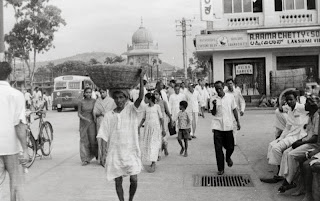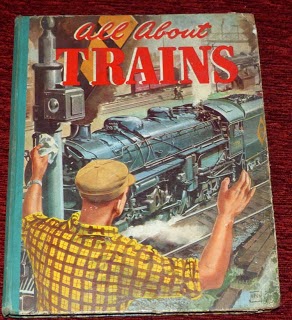In movie theatres I used to get kicks watching the tiny dust particles wafting in the air, dancing in the beam of light coming out of the projector lens. They would otherwise remain invisible! I used to do the same when my father operated the film projector at his workplace with the 16mm RCA. He was the projection operator and sound engineer. My father was an expert, having been one of the earliest students of Bangalore's Visvesvaraya Polytechnic College where he got his diploma in 1949-50. From 1951-58 he worked with distinction in the reputed Films Divisions at Bombay [now Mumbai].

Picture on the left shows my father operating a slide projector for an official programme in the early 1960s at his workplace in Mysore. He would take me to unofficial programmes and film shows organized by various in-house groups off office hours. I would sit next to the projector because I was also drawn to watching how the two film spools revolved, one dispensing and the other collecting after passing through a series of slots.
In this picture [left] he is examining a 35mm film with some colleague.
Now let me come to my adventure.
It was about 1970-71. I had just entered high school when information about toy film projectors being locally available had spread. I longed to have one. Its cost was twenty five rupees, certainly expensive for a toy at that time. My school fee was six rupees a month. I think it was my father [and not my grandfather on that occasion!] who gave the money for me to buy, reluctantly. Reluctantly, because he was aware of my 'experimenting habits', with new things and 25 was a big sum!!

The projector was something like this, but was 'silver painted':

The projector was something like this, but was 'silver painted':
With a huge sum of 25 rupees in my small shirt pocket, off I rode 'my' Robin Hood bicycle to the shop, just one kilometre from our house. A rack full of these projectors was a visual delight to me! "I want one projector." After testing the mechanics he handed it over to me. I paid the money. My new wooden gadget was carefully fastened by the carrier clip behind the saddle. Riding cautiously, feeling the toy with my hand several times if it was securely in place, I reached home.

The shop where I bought has since long been a cement shop [Narayana Shastri Road], close to where I live now. Photo taken just for this post - see the green painted one [right].

The shop where I bought has since long been a cement shop [Narayana Shastri Road], close to where I live now. Photo taken just for this post - see the green painted one [right].
After some days of trial, I was ready to arrange a 'public show'!! The news of my new toy had spread in the street. I would announce to my playmates about 'Dinu's film show' after the evening playtime so that they would inform their whereabouts to their parents beforehand.
Our hall was the audioless 'home theatre'. A white wall was the projection screen. I had to connect the projector close to the power source as I had no extra wire. The wall behind the two chairs [picture below] was the best, but sometimes I chose the wall where the rosewood trophy case is.
Our hall was the audioless 'home theatre'. A white wall was the projection screen. I had to connect the projector close to the power source as I had no extra wire. The wall behind the two chairs [picture below] was the best, but sometimes I chose the wall where the rosewood trophy case is.
.JPG)
Theatres used to dispose the cut film pieces [35 mm] in considerable lengths and these were available cheaply. Someone would pick them up from the waste bin or had some contacts with the manager. But I am unable to remember where I procured mine except for a thick roll which my aunt got from Bangalore following somebody's suggestion.The roll I am showing here is the combined one having all I had.
The 'Dinu Film Show' was arranged a few times, after dusk and would last only a few minutes! The film got unwound fast! So fast that there was no time for me to notice any wafting dust in the beam of light in the 'home theatre'!
The 60 watt bulb [projection lamp] would soon heat up the entire wooden projector. The smell of silver paint on its body would fill the room. It was time for a short cooling break! Another roll of film was loaded for another small session. Loading had to be done manually too, after switching the light on!
The projector had focusing arrangement which was a very effective mechanism made from tin sheets! Two were condensing lenses and the third one - outermost - was for focusing. Once 'loaded', the film had to be kept in motion because of chances of getting burnt by the hot light and the lens converging heat to the film, if kept stationary!
When all the film rolls were shown, the light was on for the final time. The street mates went home, but I had helluva lot of work...... to roll back the mountain of 'spent' film lying on the floor beneath the projector stool. It was great fun nevertheless.
* * * * * *
http://junkunjunk.blogspot.in/2013/02/toy-movie-film-projector.html
This is a link to my other blogpost relating to my projector - its bits!
As I had no other wood for my small bird house project in 2007, I used this! The only time any bird used it was a Great Tit and I was lucky to take photos of this rare time. You can see the silver paint of the projector still on it.
The 60 watt bulb [projection lamp] would soon heat up the entire wooden projector. The smell of silver paint on its body would fill the room. It was time for a short cooling break! Another roll of film was loaded for another small session. Loading had to be done manually too, after switching the light on!
The projector had focusing arrangement which was a very effective mechanism made from tin sheets! Two were condensing lenses and the third one - outermost - was for focusing. Once 'loaded', the film had to be kept in motion because of chances of getting burnt by the hot light and the lens converging heat to the film, if kept stationary!
When all the film rolls were shown, the light was on for the final time. The street mates went home, but I had helluva lot of work...... to roll back the mountain of 'spent' film lying on the floor beneath the projector stool. It was great fun nevertheless.
* * * * * *
http://junkunjunk.blogspot.in/2013/02/toy-movie-film-projector.html
This is a link to my other blogpost relating to my projector - its bits!
As I had no other wood for my small bird house project in 2007, I used this! The only time any bird used it was a Great Tit and I was lucky to take photos of this rare time. You can see the silver paint of the projector still on it.

.JPG)
.JPG)
.jpg)








.JPG)




.JPG)











.JPG)
.JPG)

